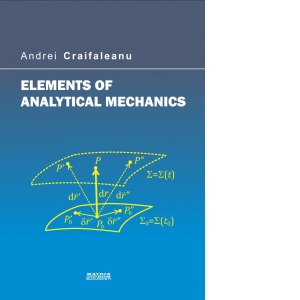Elements of analytical mechanics
de: Andrei Craifaleanu
Publicat de: Editura Matrixrom
Anunta-ma cand revine pe stoc!Chapter 1. Introductive notions
1.1. Generalities
1.2. Constraints
1.3. Generalized coordinates
1.4. Displacements
Chapter 2. Principle of virtual work
2.1. Generalities
2.2. The first form of the principle of virtual work
2.3. The second form of the principle of virtual work in the case of a system of
material points acted by arbitrary forces
2.4. The second form of the principle of virtual work in the case of a system of
material points acted by conservative forces
2.5. Torricelli’s principle
2.6. Principle of virtual power
Chapter 3. D’Alembert’s principle
3.1. Generalities
3.2. D’Alembert’s principle for a material point
3.3. D’Alembert’s principle for a system of material points
3.4. Reduction elements of the inertia forces with respect to a point
3.5. Reduction elements of the inertia forces with respect to the center of mass
3.6. D’Alembert’s principle for a rigid body
3.7. Calculation of the reduction elements of the inertia forces acting upon a
rigid
Cuprins:
Chapter 4. Lagrange’s equations
4.1. Generalities
4.2. D’Alembert-Lagrange equation
4.3. Lagrange’s equations of the first kind
4.4. Lagrange’s equations of the second kind in the case of arbitrary forces
4.5. Lagrange’s equations of the second kind in the case of conservative forces
Chapter 5. Lagrange’s equations for systems with dependent variables
5.1. Generalities
5.2. Case of holonomic systems with dependent variables
5.3. Case of non-holonomic systems with linear velocity constraints
Chapter 6. Hamilton’s canonical equations
6.1. Generalities
6.2. Generalized momenta
6.3. Hamilton function
6.4. Hamilton’s canonical equations
6.5. Hamilton’s canonical equations in the case of a system acted by conservative forces
References
| General | |
| Autor | Andrei Craifaleanu |
| Categorii | Stiinta / Tehnica, Mecanica, Carti |
| Editura | Editura Matrixrom |
| ISBN | 9786062507015 |
| Limba | Engleza |






